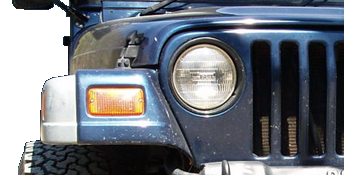All right, I'm back. Sorry for the wait. It's been a long time since I've looked at any of this stuff, but I'll throw out some ideas, and y'all can poke holes in them.
So, here's what we know:
5/8” UNC grade 8 bolt in single shear, frame side track bar bolt on the front axle
According to the owner, the bolt was installed a year (+/-) prior to failure. The bolt is believed to be new at time of install and was not disturbed after initial installation.
The bolt should have a nominal shear strength of somewhere around 25,000# when properly installed, recommended torque value for 5/8" UNC is probably something like 150-175 ft-lbs, at which point it’s going to develop somewhere between 10-20k# in tension along its length. This represents the “normal” condition for this bolt in service.
The loads required to shear the bolt outright are enough to pretzel the front axle, track bar, and anything else connected to them. The stock lower track bar bolt, for example, should shear neatly at about half or 2/3s that load (despite being double shear). Yet we know that it failed. The question at hand is why. The bolt gives us some clues.
The broken face appears to have three distinct zones, roughly divided into thirds – a smooth portion, a rough portion, and a fractured/torn portion. That indicates a specific sort of failure – the smooth portion is what’s left of a crack progression that started at the root of a thread near where the track bar joint meets the frame-side track bar bracket. The rough portion and the fractured/torn portion happened right at (or slightly before) the final failure.
So why did it crack? As you torque a threaded connection like a nut and bolt, the torque value has a roughly linear relationship with the tension in the bolt. The bolt stretches slightly as the torque value increases. The “spec” torque equates to a tension in the bolt that’s about 3/4s of the yield strength of the steel, so if you don’t overtighten the nut, the steel maintains its original yield strength and can be reused repeatedly in most applications. If you tighten a bolt to something less than its specified torque, it can still be “tight”, the bolt will still have stretched, but the tension in the bolt and the clamping force generated by the bolt will be some percentage less than the desired value.
Let’s say a connection must be designed for a load of X, with the fasteners sized to resist a load of 1.5x. Rather than being torqued to 150ft-lbs, the fasteners are only torqued to 75. Now they can only support a load of 3/4X. Since X represents the maximum value that might ever be seen, you might go a long time without ever coming close to it. Sooner or later, you hit a value of .8X, the fasteners allow the connection to stretch or shift (thousandths of an inch being all that’s required), the fastener is subjected to a shear load that is close to the capacity of the bolt at its minor diameter (it’s conceptually like a hitch pin at this point), and a small crack forms at the root of a thread. Subsequent loading causes the crack to progress through the fastener. The bigger the crack, the weaker the fastener, the smaller the load needed to grow the crack. Depending on the intended usage, it might take years for the crack to progress, so it’s not uncommon to see rust in the smooth portion of the face. At some point during that period, if you put a torque wrench on the nut, it might have felt tight, or maybe taken up a bit of slack, but the bolt would have twisted in two long before you got to 150 ft-lbs. I'd bet the witness marks on the bolt shaft were generated during this time. It's hard to tell from the picture, but there might be some flattening on the face of the threads and some galling or witness marks on the face of the bolt head and the face of the nut. If so, those would be evidence that the bolt moved around some before it broke. It doesn't prove or disprove (could be caused by other things as well), but if it's there, it would be consistent with the theory.


